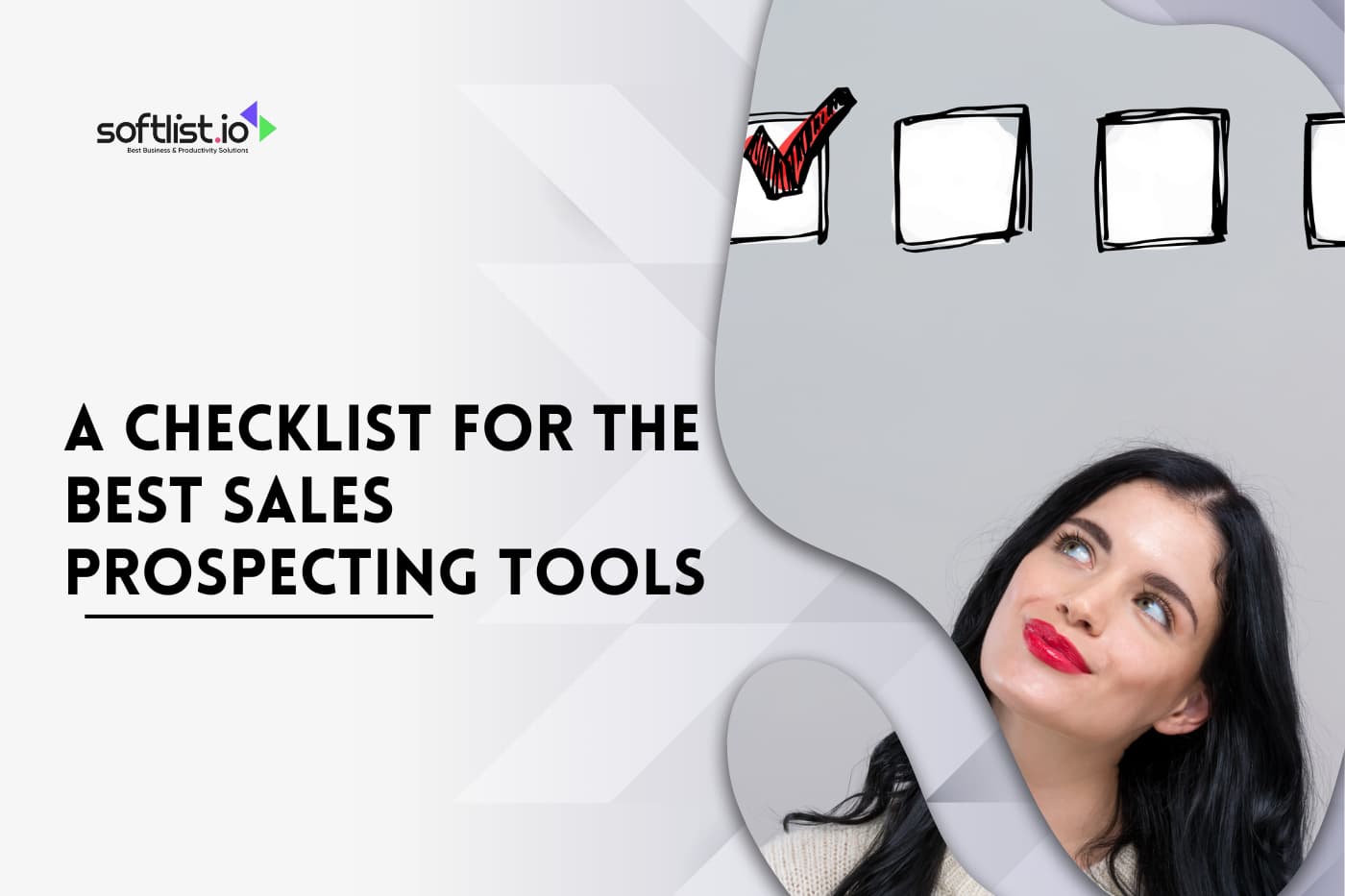Finding the right sales tool is challenging. Because there are so many tools, it takes a lot of work for sales teams to know which will help them make sales. This means they waste time on jobs that don’t help them.
Their attention is thrown off when they try to do what’s essential: meet new people and close deals.
Our blog has a manageable list of the best tools for finding new sales prospects. You can use this list to determine which tools will help you know more about prospecting tools and do your job better and faster.
Key Takeaways
- Automation and Efficiency: Modern sales prospecting tools incorporate automation features to streamline tasks such as lead generation, data collection, and follow-ups, allowing sales teams to focus more on closing deals.
- Integration Capabilities: Effective tools integrate seamlessly with existing CRM systems, like HubSpot, enhancing workflow automation and ensuring that all sales activities and data are centralized.
- Data Accuracy and Enrichment: High-quality prospecting tools provide real-time data updates and data cleansing functionalities to ensure the information sales teams work with is accurate and current, which is crucial for successful prospecting.
- AI-Driven Insights: Advanced tools use artificial intelligence and machine learning to offer predictive analytics and personalized outreach strategies, helping sales reps prioritize and effectively engage the most promising leads.
- User Experience: A user-friendly interface and customizable dashboards are essential for adopting and effectively using prospecting tools. These allow sales professionals to navigate and utilize the tool’s features quickly.
What are the Key Features of Cutting-Edge Prospecting Tools?

Source: Canva Pro
Automation Capabilities
One of the most significant advancements in sales prospecting tools is automation. Automation tools for sales streamline the prospecting process, allowing sales reps to focus on closing deals rather than mundane tasks. Key automation features include:
- Lead Generation and Data Collection: Automated tools can continuously gather data on potential leads, ensuring your sales team always has fresh, relevant information.
- Workflow Automation: Integrating with CRM systems like HubSpot, these tools automate follow-ups, email sequences, and task assignments, enhancing the overall efficiency of your sales process.
Data Accuracy and Enrichment
Having accurate and enriched data is crucial for effective sales prospecting. Cutting-edge prospecting tools provide:
- Real-Time Data Updates: Ensure your sales team is working with the most current information, reducing the chances of missed opportunities.
- Data Cleansing and Validation: These features help maintain a clean database, removing duplicates and outdated information, which is vital for successful B2B sales prospecting.
Artificial Intelligence and Machine Learning
AI and ML are transforming sales prospecting techniques by providing deeper insights and predictive analytics:
- Predictive Analytics for Lead Scoring: These tools can analyze historical data to predict which leads are most likely to convert, helping sales reps prioritize their efforts.
- AI-Driven Insights: AI tools offer personalized recommendations and insights, improving targeting and engagement strategies and thus enhancing the sales pipeline.
User Experience and Interface
A user-friendly interface is essential for the adoption and effective use of sales prospecting tools:
- Intuitive Design: The best tools offer easy navigation and a clean layout, reducing the learning curve for sales professionals.
- Customizable Dashboards: Personalized dashboards and reporting tools enable sales teams to track their progress and performance metrics easily.
Essential Components of a Prospecting Tool

Source: Canva Pro
Lead Management
Effective lead management is a cornerstone of any robust sales prospecting tool. Key components include:
- Contact Management: A centralized database where sales reps can store and manage all their contacts, ensuring easy access and organization.
- Lead Nurturing Capabilities: Tools that help automate and personalize follow-up communications, making the sales engagement process more effective.
Communication Tools
Seamless communication is vital for successful sales prospecting. Modern tools offer:
- Email Automation and Tracking: Automate email campaigns and track open rates, click-through rates, and responses to measure engagement.
- Social Media Integration: Tools like LinkedIn Sales Navigator allow sales professionals to connect and engage with prospects on social media platforms, expanding their reach and influence.
Collaboration Features
Sales is often a team effort, and having tools that facilitate collaboration can significantly enhance productivity:
- Team Collaboration Tools: Shared workspaces and communication logs ensure everyone on the sales team is on the same page.
- Shared Databases: A unified database where sales reps can access shared information and real-time updates.
Integration with Other Tools
Integration capabilities are crucial for a seamless workflow:
- Compatibility with Existing Software: Ensure the prospecting tool integrates well with your existing CRM, marketing automation tools, and other sales software.
- API Access for Custom Integrations: Allows customization and integration with unique business processes and additional tools to find and engage leads effectively.
How to Evaluate Prospecting Tools?

Source: Canva Pro
Understand Your Sales Prospecting Process
The first step in evaluating prospecting tools is clearly understanding your existing sales prospecting process. Identify the stages of your sales cycle, from generating initial sales leads to closing deals.
This understanding will help you pinpoint what features you need in a sales prospecting tool, whether for B2B prospecting, managing sales calls, or enhancing outbound sales strategies.
List of the Best Sales Prospecting Tools for this year
Compile a list of the best sales prospecting tools available on the market. Tools like LinkedIn Sales Navigator are powerful sales intelligence platforms for sales and marketing professionals.
Consider the benefits of sales prospecting tools such as enhanced sales CRM functionalities, sales automation features, and tools to help find contact details—all of which can significantly improve engagement and efficiency.
Evaluate Sales Intelligence Capabilities
Sales intelligence is a critical component of any effective B2B sales prospecting tool. Assess how each tool allows your sales representative to gather actionable insights on potential customers.
The best prospecting tools for sales should offer comprehensive data that aids in understanding buyer behavior, industry trends, and competitive landscapes.
Check for Integration with Your Current Systems
Integration capabilities ensure that new sales prospecting software works seamlessly with your existing sales and marketing systems.
Tools that integrate well with your sales CRM and other engagement tools can streamline the entire sales funnel, making the transition smooth and maintaining the integrity of your data.
Consider the Tool’s Usability and Support
The best prospecting tools are powerful and user-friendly. They should enable your sales teams to use sales intelligence effectively without a steep learning curve.
Additionally, consider the level of customer support provided. A good prospecting tool will offer substantial support to help sales teams utilize the tool to its full potential and troubleshoot any issues that may arise.
Look for Customization and Scalability
The ability to customize a sales prospecting tool to fit your specific business needs and its ability to scale as your business grows is essential factors.
The best sales prospecting tools for this year should be adaptable to the changing dynamics of the market and your business, helping sales teams continually align their sales strategies with company goals.
Assess Cost-Effectiveness
Finally, evaluate the cost-effectiveness of each prospecting tool. Determine if the benefits and features provided justify the investment and how they contribute to achieving your sales goals.
Many sales prospecting tools offer different pricing tiers, so it’s essential to select one that provides the best value for your specific needs.
Final Thoughts
Our checklist for the best sales prospecting tools is designed to streamline your sales process, allowing you to focus more on engaging with potential clients and closing deals. These tools can transform how you track leads, manage data, and interact with prospects, making every sales journey smoother and more effective.
If you want to expand your toolkit further, don’t miss our detailed “SaaS Tools” articles. These resources delve into various software solutions that can enhance your business operations.
Additionally, consider exploring our “Top 10 AI Marketing Tools” article. This review offers a deep dive into the latest AI technologies reshaping marketing strategies.
Check out our Deals and Offers page for great deals to save your business money. See our Top 10 list on the Top Product Reviews page for business needs.
Frequently Asked Questions
What Is a Prospecting Tool?
A prospecting tool is software designed to help businesses identify and engage potential customers, manage prospects efficiently, and streamline their prospecting efforts.
Why Should I Use Cutting-Edge Prospecting Tools?
Cutting-edge prospecting tools help sales teams close more deals by offering advanced features like automation, integration, and real-time analytics.
These tools can help enhance the efficiency and effectiveness of your prospecting efforts, making them the best fit for modern sales strategies.
How Can I Ensure the Data Accuracy of My Prospecting Tools?
To maintain high data quality, use tools that offer data cleansing and enrichment features, regularly update your database, and verify data from reliable sources.
Prospecting tools to find contact information accurately are crucial for successful prospecting efforts.
How Do I Integrate Prospecting Tools with My Existing Systems?
Ensure the prospecting tool supports integration with your CRM, email, and other systems.
Follow the integration steps provided by the tool and address any compatibility issues with technical support. All-in-one sales tools can help simplify this process.
What Kpis Should I Track to Measure the Effectiveness of My Prospecting Tools?
Track KPIs such as the number of leads generated, conversion rates, lead response time, engagement metrics, and return on investment (ROI) to evaluate the performance of your sales prospecting tools.
This analysis helps you understand how well the tools aid your prospecting efforts.






